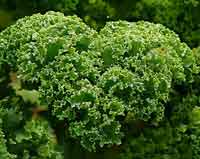Belonging to the family, Brassicaceae, kale has been rediscovered as a superfood. It is mostly rich in lutein, folate, vitamins A,C, E and K, magnesium, iron and contains a load of anti-oxidants.
It originated around the Mediterranean and was grown for many centuries until the Middle Ages. In more modern times, it became popular in post-war periods because it was easy to grow and very nutritious. However, in the USA ornamental varieties were favoured for use in floral arrangements – even wedding bouquets – and it even has its own national day, the first Wednesday of October.
There are over 50 types of kale, both ornamental and edible. However, three varieties are readily available to grow:
Dwarf Curly, a compact, leafy green with mildly sweet, crinkled leaves
Red Russian, a blue-green variety with purplish-red veins
Black Toscana (Cavalo Nero – pictured above), a long dark-green/blue leaf variety.
Planting Schedule
 Warm areas: March to April (in seed trays*), May to June (transplant seedlings)
Warm areas: March to April (in seed trays*), May to June (transplant seedlings)
Temperate areas: March to April (in seed trays*), May to June (transplant seedlings)
Cool areas: January to February (in seed trays*) April to May (transplant seedlings)
*You could also try sowing seeds directly in the soil if the soil is not too hot
Position, Position, Position
 In temperate areas, all three varieties of kale like full sun. But in hotter regions, part shade will assist its growth. Also, being a winter vegetable, kale can tolerate mild frost, with Red Russian still able to thrive and survive at a temperature of -10 degrees C. Actually, frost tends to intensify its sweetness.
In temperate areas, all three varieties of kale like full sun. But in hotter regions, part shade will assist its growth. Also, being a winter vegetable, kale can tolerate mild frost, with Red Russian still able to thrive and survive at a temperature of -10 degrees C. Actually, frost tends to intensify its sweetness.
Talking Dirty
Kale, like many vegetables, prefers a well-drained soil, rich in organic matter. However, its pH range is a little towards the acidic side with a preference for a pH of 5.5 – 6.5. If your soil is rich in clay you might add some sand and compost. If it is very sandy, try adding powdered bentonite clay or compost. Actually, compost is the magic ingredient for any soil! Another useful addition to sandy soil is coir peat (ground coconut fibre). Coir is available in blocks which expand when soaked in water and will hold moisture when added to soil.
Feed Me!
Since kale is a leafy green, it needs a rich nitrogen source to thrive. A green manure crop planted and dug in before planting kale is ideal. Or aged manures, pelletised chicken manure or “blood and bone” are important soil additions, but make sure you don’t overdo them – little and often is the way to go. Drinks of fish emulsion and seaweed extracts during the growing season will provide both food and moisture.
What about the Water?
Although kale is a winter vegetable and drying out is not such a problem, regular watering is required to provide the moisture it requires. Mulching around plants will protect the soil from moisture loss.
Are we there yet?
 For most varieties harvest can start after around 7 – 8 weeks. If there are too many leaves for your household, take them to your local Harvest Swap, feed them to your chooks or add them to your compost heap or worm farm!
For most varieties harvest can start after around 7 – 8 weeks. If there are too many leaves for your household, take them to your local Harvest Swap, feed them to your chooks or add them to your compost heap or worm farm!
Pests and the Rest
Kale is generally pest-resistant, but can fall prey to cabbage aphids, harlequin bugs and cabbage white butterfly. The best way to deal with such pests is to prevent them by crop rotation, keeping the soil healthy and encouraging predatory insects into the garden by including flowering plants. But if all that fails, try hosing small ones off and picking caterpillars and larger bugs off and dropping them into a bottle containing soapy water.
Good Neighbours
Rhubarb, onions, cucumber, beets, celery, marigold, nasturtium, herbs (sage, dill, camomile).
Bad Neighbours
Climbing beans, mustard, strawberry or members of the nightshade family (tomato, chili, capsicum, eggplant).
Eat Me!
There are many recipes now for kale. When used raw it needs some extra attention to reduce bitterness. This may be by chopping it finely into well-dressed salads or including it in a smoothie with nut milk and fruit. However, it has a delicious savory flavour when chopped and baked to make “chips” or steamed, sauteed or stir-fried with garlic or onions. Just search online for one of the hundreds of recipes out there!
Related Articles:
Tomato Brown Rugose Fruit Virus (ToBRFV)
Tomato Brown Rugose Fruit Virus (ToBRFV) is a plant virus that causes severe crop losses (up to 75%) in tomatoes, but also in peppers (capsicums and…
Garden Journaling – Slow down to tune in.
As we move through the year and our gardens evolve, there's something magical about documenting the journey. Garden journaling is an art that enables…


